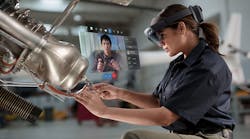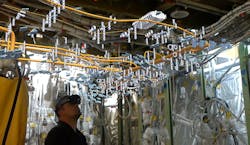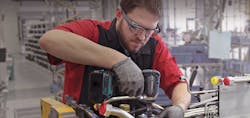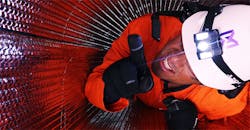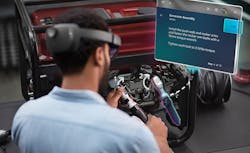Everything in our society seems to be getting smarter. Fridges. Factories. Cities. They demand more sensors, more data, more everything. This puts Boeing in an unenviable position as a manufacturer, as it must push for continuous improvement and advancement in making new aircrafts.
In the case of the KC-767 refueling tanker, the job is very complex. Each requires aircraft mechanics to install "2.5 times the wiring in one times the plane," explains Brian Laughlin, IT technical fellow at Boeing. The task often required workers to recall directions from a 2D, 20-foot-or-longer paper diagram and translate them to the 3D world. To make matters worse, those wires are packed in quite tight. And if the mechanic messes up, the bundles of cable must all be undone to correct the error. Correction: Not if, but when.
"In the past we had quite a few mistakes made," says Laughlin, though it's not due to malfeasance but rather humans' shortcomings. "The things we're asking them to do are nearly superhuman; it's really, really tough." The true problem is that everything is getting smarter except for us. Even our brains, which have allowed us to do so much, have their limits. Laughlin, who holds a Ph.D. in human factors and a master's degree in experimental psychology, knows all about the brain's limitations, such as in memory, as humans have trouble even retaining simple seven-digit phone numbers, let alone the schematics needed to install miles of wire in a jet. His job is to find the right technology to overcome them, leading to Boeing's use of the Microsoft HoloLens headset, which allowed them to transfer the 3D work instructions directly into their workspace via a high-tech visor. "It essentially makes us bionic," Laughlin says of the HoloLens. "It addresses a lot of problems that we as humans have in terms of how we recall, compare and process information." The HoloLens employs what Microsoft calls mixed reality, an advanced form of immersive computing (which also includes augmented and virtual reality) that overlays digital 3D images onto the visor in a way that makes these digital assets appear as part of the real world. This is done through Simultaneous Localization and Mapping (SLAM), a tech also used by robots and drones for navigation. There's no end to how the tech can be applied, with fascinating cases in medicine and design. The U.S. Army awarded Microsoft a $480 million contract and plans to use the HoloLens for training and combat. "We have unlocked super-powers for hundreds of thousands of people who go to work every day," says Greg Sullivan, director of communications at Microsoft. "HoloLens is changing how we work, learn, communicate and get things done. "Boeing was Microsoft's first industrial partner with the HoloLens, which was released in 2016. Laughlin, who has been with Boeing since 1991, also points out that Boeing innovators Tom Caudell and David Mizell coined the term augmented reality in the 1990s. They developed early iterations of smartglasses to assemble wiring looms for the 777, overlaying digital images onto peg boards. In the current application, mixed reality makes that superhuman memory game into child's play, inserting ghost wiring into the electrician's field of view that they then need to trace with the actual cables. "I can just walk in and put on the HoloLens and then there's my wiring harness floating in space," Laughlin explains. "Then I just connect the dots with the wiring harness. It's far simpler and easier to understand." Easy, yes, but more importantly, it's effective. "Our theory studies have shown a 90% improvement in first-time quality when compared to using two-dimensional information on the airplane, along with a 30% reduction in time spent doing a job," says Paul Davies, Boeing Research & Technology associate technical fellow. Besides not having to keep referring to the paper diagram, the error-proofing method also saves time from having to correct improper wiring.
"I don't want to unduly lead people to believe that you go buy HoloLens and suddenly everything magically becomes better, because clearly it does not," Laughlin says. "The magic comes in actually going and doing the process work ahead of time so that you really understand what the process flows are and what each step entails, and then take a wire brush and strip away all the waste that you can out of that."
Once the process is as lean as possible, Lauglin says, that's when you drop in the right technology.
"What you tend to get is a force multiplier instead of an added benefit," Laughlin says.
Boeing has previously used Google Glass Enterprise Edition in conjunction with software made by Upskill to cut production time by 30%, reduce errors to almost zero and potentially save millions per jet.
The New Fashion Trend
That's just one use case in one company. Forrester predicted in 2016 that 14 million workers would use smart glasses and similar devices to increase performance by 2025. Think of all the things you can do with a smart phone or tablet, like check work instructions, scan bar codes, record video or make a call. Now imagine tying all that into your system's cloud, not needing to use your hands to access any of it.
The new wave of industrial wearables comes in several form factors. Industrialized versions range from under $2,000 to more than $5,000. They do require serious planning, app building and extensive collaboration between IT and operations. The result: the instant evolution of the industrial worker. This empowers people to catch up to all those other smart plant assets growing at an exponential rate.
You probably know about the insane upswing the Internet of Things is projected to take in the next few years. According to Statista, the number of connected devices will nearly triple between now and 2025, to 75 billion. In the plant and across every business, all those connected things will be creating hot new data streams, which amounts to a bunch of wasted steam if you can’t convert it into actionable data. These headsets and smartglasses essentially funnel that data when appropriate to the boots-on-the-ground workers who put it to use, a reason analysts predict the popularity of enterprise wearables to match that of the IIoT. The industrial wearable segment was $1.5 billion in 2017, and MarketWatch expects it to rise by 73%, to $2.6 billion in 2023.
But how will they make a difference? Where? In the 1990s, as AOL spammed our snail-mail boxes with free trial discs, no one could have predicted how the internet would evolve in 20 years. Likewise, the array of face-hugging tech available have equal potential to redefine how manufacturers interface with their machines.
Fixing Old Problems
Thinking of wearable computers as different tools on your belt is even more appropriate considering how mainstream they will be in maintenance and field service. Research & Markets projects that in five years, the market for using AR in maintenance, repair and overhaul (MRO) applications will grow from $403.3 million to $3.31 billion.
"If an error code pops up, their technician can get instant live support or visual guidance on smart glasses or mobile devices, which results in 90% lower search times," says Dirk Schart, president of Re’flekt, of a recent success story his AR software solutions provider had with one of the world's leading automation companies.
"The risk of errors in both, routine repair and maintenance procedures as well as in complex tasks, can be reduced by up to 40%," he adds.
Even the most basic pairs of smart glasses have the features needed to achieve these results and greatly cut machine downtime: a camera, wireless connectivity and a display window.
With these tools attached to their faces, workers can livestream a repair or install to a remote expert who can see exactly what is going on and recommend actions verbally or through telestrations. Fixes can be made without having to hold a smartphone or tablet.
This hands-free function is the most important factor and why wearables could phase out tablets in the next few years. That's not so bold a claim if you are familiar with the success of RealWear, a Vancouver-based "knowledge transfer" company that manufactures the ruggedized HMT-1, (short for "head-mounted tablet"). They also have an intrinsically safe version for refineries and other volatile spaces.
